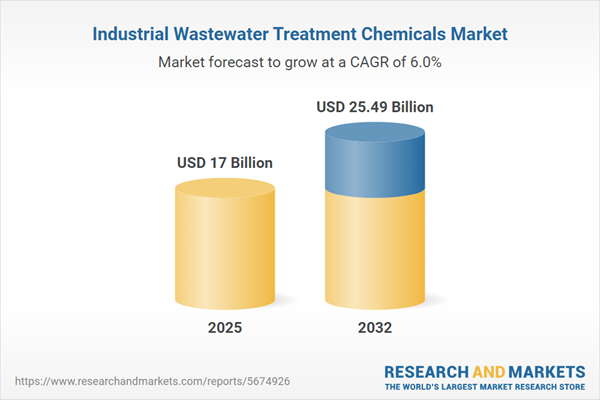Speak directly to the analyst to clarify any post sales queries you may have.
In today’s regulatory landscape, industrial wastewater treatment chemicals are fundamental for organizations aiming to achieve compliance, efficiency, and sustainable operations. Senior leaders must have insights into which solutions solve technical challenges and meet evolving standards.
Market Snapshot: Industrial Wastewater Treatment Chemicals Market
The industrial wastewater treatment chemicals market is projected to expand from USD 16.05 billion in 2024 to USD 17.00 billion in 2025, reaching USD 25.49 billion by 2032. Market momentum is shaped by stricter regulations, discovery of emerging contaminants, and consistently rising expectations for operational reliability. Leading companies are investing in advanced chemical solutions that address compliance needs while supporting environmental objectives. Cross-industry adoption and global deployment give organizations flexibility to adapt operations in response to shifting economic conditions or new regulatory demands. The market’s resilience reflects both the demand for risk mitigation and the growing necessity of environmental stewardship.
Scope & Segmentation
- Chemical Types: Includes biocides, disinfectants, coagulants, flocculants, corrosion inhibitors, scale inhibitors, defoamers, demulsifiers, oxygen scavengers, acids, alkalis, and phosphorus removers, essential for system reliability and contaminant control across varied industrial processes.
- End Use Industries: Chemical processing, mining, oil and gas, pharmaceuticals, municipal water, pulp and paper, textiles, food and beverage, and power generation each require tailored wastewater treatment strategies to address sector-specific contaminants and regional compliance.
- Treatment Stages: Spanning pre-treatment to tertiary processing, the solutions utilize ion exchange, reverse osmosis, and closed-loop recycling technologies to meet unique pollution and operational requirements at each facility.
- Dosing Forms: Available in dry, gel, and liquid forms, these chemical solutions offer operational flexibility, supporting seamless integration with automated plant processes and variable operational scales.
- Sales Channels: Organizations procure products through direct sales, distributor networks, and digital procurement platforms, aligning distribution strategies with production and supply chain agility.
- Key Regions: Adoption dynamics are driven by regulatory pressures in the Americas, advanced infrastructure in Europe, fast-evolving priorities in the Asia-Pacific, and specific industrial needs across the Middle East & Africa.
- Notable Companies: Market leaders like Ecolab Inc., Kemira Oyj, SNF S.A.S., Nouryon Holding B.V., Kurita Water Industries Ltd., SUEZ S.A., Solvay S.A., BASF SE, Dow Inc., and DuPont de Nemours, Inc. deliver scalable and technical solutions to global markets.
Key Takeaways for Senior Decision-Makers
- Developing proactive procurement and inventory plans helps enhance operational continuity and supports agile response to regulatory or supply chain changes.
- Prioritizing sustainable chemical technologies aligns plant operations with environmental objectives and improves resource efficiency enterprise-wide.
- Implementing automated dosing and digital monitoring platforms offers real-time insights for rapid optimization, helping maintain consistent treatment performance.
- Consulting with specialized suppliers ensures that chemical selection matches increasingly complex and variable wastewater composition scenarios.
- Leveraging digital procurement alongside strong logistics networks safeguards against supply interruptions and maintains production uptime.
Tariff Impact & Supply Chain Shifts
Recent modifications to U.S. tariff policy have made localized sourcing and diversified supplier networks increasingly crucial. Organizations that update procurement strategies and build resilience into sourcing models position themselves to mitigate trade-related risks and ensure uninterrupted access to essential chemicals.
Methodology & Data Sources
This analysis draws from in-depth interviews with senior industry executives, comprehensive secondary research, and input from industrial wastewater treatment experts. All findings are supported by project-level data and systematic reviews of top industry datasets.
Why This Report Matters
- Presents actionable, data-driven insight on technological trends and regulatory developments influencing procurement and production strategies in the industrial wastewater treatment chemicals sector.
- Equips leadership teams with segmentation analysis and regional perspectives for more informed investment and operational decisions.
- Enables organizations to anticipate compliance requirements and sustain environmental practices while advancing process optimization.
Conclusion
Adopting insights from this report enables executives to strengthen wastewater management, anticipate future regulatory shifts, and drive more resilient, sustainable industrial operations.
Additional Product Information:
- Purchase of this report includes 1 year online access with quarterly updates.
- This report can be updated on request. Please contact our Customer Experience team using the Ask a Question widget on our website.
Table of Contents
3. Executive Summary
4. Market Overview
7. Cumulative Impact of Artificial Intelligence 2025
Companies Mentioned
The companies profiled in this Industrial Wastewater Treatment Chemicals market report include:- Ecolab Inc.
- Kemira Oyj
- SNF S.A.S.
- Nouryon Holding B.V.
- Kurita Water Industries Ltd.
- SUEZ S.A.
- Solvay S.A.
- BASF SE
- Dow Inc.
- DuPont de Nemours, Inc.
Table Information
| Report Attribute | Details |
|---|---|
| No. of Pages | 192 |
| Published | November 2025 |
| Forecast Period | 2025 - 2032 |
| Estimated Market Value ( USD | $ 17 Billion |
| Forecasted Market Value ( USD | $ 25.49 Billion |
| Compound Annual Growth Rate | 5.9% |
| Regions Covered | Global |
| No. of Companies Mentioned | 11 |









